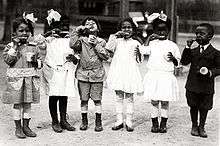Normal School for Colored Girls
|
Miner Normal School | |
 | |
 | |
| Location | 2565 Georgia Ave., NW., Washington, D.C. |
|---|---|
| Coordinates | 38°55′24″N 77°1′21″W / 38.92333°N 77.02250°WCoordinates: 38°55′24″N 77°1′21″W / 38.92333°N 77.02250°W |
| Built | 1913 |
| Architect | Leon E. Dessez; Snowden Ashford |
| Architectural style | Colonial Revival |
| NRHP Reference # | 91001490[1] |
| Added to NRHP | October 11, 1991 |
Normal School for Colored Girls established in Washington, D.C., in 1851 as an institution of learning and training for young African-American women, especially to train teachers.[2][3] As Miner Normal School, it is listed on the National Register of Historic Places.
Background
The school was founded by Myrtilla Miner with the encouragement from Henry Ward Beecher and funding from a Quaker philanthropist after the school in Mississippi where she taught refused her permission to conduct classes for African American girls.[3] While inappropriate today, the use of the term "colored" was considered polite in 19th century speech. However, some sources refer to the school as the "Miner School for Girls".
Although the school offered primary schooling and classes in domestic skills, its emphasis from the outset was on training teachers. Miner stressed hygiene and nature study in addition to rigorous academic training.[3]
Within two months of opening, school enrollment grew from six to forty. Despite hostility from a portion of the community, the school prospered with the help of continued contributions from Quakers and a gift from Harriet Beecher Stowe (sister of Beecher) of $1,000 of the royalties she earned from Uncle Tom's Cabin.[3]
As it grew, the school was forced to move three times in its first two years, but in 1854 it settled on a 3-acre (1.2-hectare) lot with house and barn on the edge of the city. Around this time, Emily Edmonson enrolled in the school. To help protect the school and those involved with it, the Edmonson family took up residence on the grounds and both Emily Edmonson and Myrtilla Miner learned to shoot.[3][4]

In 1856 the school came under the care of a board of trustees, among whom were Beecher and wealthy Quaker Johns Hopkins. By 1858 six former students were teaching in schools of their own. By that time Miner's connection with the school had been lessened by her failing health and from 1857 Emily Howland was in charge.[3]
In 1860 the school had to be closed, and the next year Miner went to California in an attempt to regain her health. A carriage accident in 1864 ended that hope, and Miner died shortly after her return to Washington, D.C.[3]

During the American Civil War, on March 3, 1863, the United States Senate granted the school a charter as the "Institution for the Education of Colored Youth" and named Henry Addison, John C. Underwood, George C. Abbott, William H. Channing, Nancy M. Johnson, and Myrtella Miner as directors.[5]
From 1871 to 1876 the school was associated with Howard University, and in 1879, as "Miner Normal School", it became part of the District of Columbia public school system. In 1929, an act of the U.S. Congress accredited it as "Miner Teachers College".[2][3][6]
The current Colonial Revival building was built in 1913, designed by Leon E. Dessez and Snowden Ashford.[1]
In 1955 the school merged with Wilson Teachers College to form the "District of Columbia Teachers College". In 1976, this was incorporated into the University of the District of Columbia.[2][6]
The building was listed on the National Register of Historic Places in 1991.[1]
Notable people
Students
- Louise Daniel Hutchinson historian, attended the school.[7]
- Ruby Hurley graduate, NAACP leader
Faculty and staff
- Marguerite Williams, American geologist
See also
References
- 1 2 3 National Park Service (2008-04-15). "National Register Information System". National Register of Historic Places. National Park Service.
- 1 2 3 "University of the District of Columbia". Peterson's. 2002. Retrieved 2008-10-22.
- 1 2 3 4 5 6 7 8 "Myrtilla Miner". Encyclopædia Britannica. 2008. Retrieved 2008-10-22.
- ↑ http://www.montgomerycountymd.gov/cfwtmpl.asp?url=/Content/CFW/MCWHProject/MCWHArchives/MCWomensHistoryEdmonson.asp Harriet Beecher Stowe, A Key to Uncle Tom’s Cabin, (1852), John H. Paynter, Fugitives of the Pearl, Washington DC: Associated Publishers (1930) and Mary Kay Ricks, "A Passage to Freedom", Washington Post Magazine (February 17, 2002): 21-36
- ↑ congressional charter by S. 536
- 1 2 History of the University of the District of Columbia
- ↑ "Louise Daniel Hutchinson Interviews". Record Unit 9558. Smithsonian Institution Archives. Retrieved 20 April 2012.